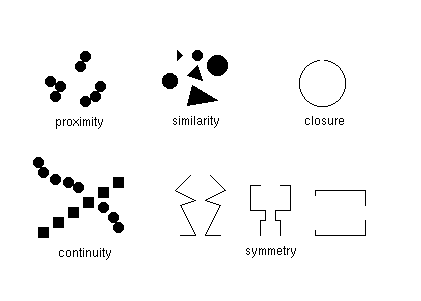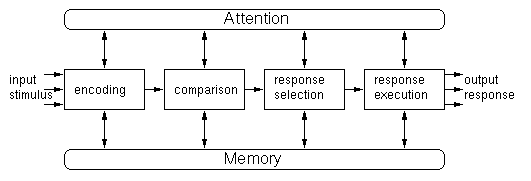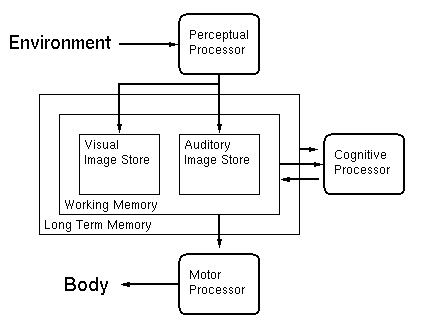Psychological Issues in HCI - CM212/CM304
Nick Gibbins
MMRG
Overview
- Cognition
- Human Information Processing
- Perception
- Attention
- Memory
Cognition
The process by which we become acquainted with things or gain
knowledge.
Human Information Processing
Sequential four-stage process:
- encode stimulus from the environment into internal
representation
- compare encoded stimulus with memorised representation
- formulate response to encoded stimulus
- take action
Perception
"Perception is the immediate discriminatory response of an
organism to energy activating sense organs ... To discriminate
is to make a choice reaction in which contextual condition
play a deciding role"
(Bartley, 1969)
"The term perception refers to the means by which information
acquired from the environment via the sense organs is
translated into experiences of objects, events, sounds,
tastes, etc."
(Roth, 1986)
Perceptual Modalities
A modality is an `avenue of sensation'.
Several are important to a study of interface design:
- visual
- most important to interface design
- sound
- touch
- used in multimedia and virtual reality
Perception Classes
Two main approaches to perception:
- Constructivist
- Ecological
Constructivist Perception
World view constructed from information in the environment and
previously stored knowledge.
"We are so familiar with seeing, that it takes a leap of
imagination to realize that there are problems to be
solved. But consider it. We are given tiny distorted
up-side-down images in the eyes, and we see separate solid
objects in surrounding space. From the patterns of stimulation
in the retinas, we perceive the world of objects, and this is
nothing short of a miracle."
(Gregory, 1978)
Constructivist Perception Concepts
- context
- used to resolve ambiguous stimuli
- gestalt:
- innate laws of organisation
Ecological Perception
Allows information to be picked up rather than processed.
Much higher level model than retinal images, dealing with
movements, surfaces, optic flows, etc.
"This is a radical hypothesis, for it implies that the
`values' and `meanings' of things in the environment can be
directly perceived."
(Gibson, 1979)
Ecological Perception Concepts
- affordance:
- a possibility for action afforded to a perceiver by an
object
Extending the Human Information Processor
Cognition is viewed in terms of:
- how information is perceived
- how information is attended
- how information is processed and stored
Attention
"Everyone knows what attention is. It is the taking
possession of mind, in clear and vivid form, of one out of
what seem several simultaneously possible objects or trains of
thought ... It requires withdrawal from some things in order
to deal effectively with others"
(James, 1890)
Attention Concepts
- Focused attention
- Divided attention
- Several techniques for guiding attention
- structure information
- use spatial or temporal cues
- use colour
- use alerting techniques
The Multi-store Model of Human Memory
Sensory Registers
Modality-specific temporary buffers.
- Encoding:
- physical (unprocessed)
- Latency:
- 200 msec (visual) 1.5 sec (audible)
Working Memory
`active' memory
- Encoding:
- acoustic or visual
- Capacity:
- 7 +- 2 chunks
- Latency:
- ~ 7 sec
Latency depends on the number of chunks in active memory.
Long Term Memory
- Encoding:
- semantic
- Capacity:
- unlimited?
- Latency:
- unlimited?
Memory Concepts
- priming:
- recall is affected by prior information
(facilitation,interference)
- gist:
- redundant information is ignored
- elaboration:
- existing knowledge used to elaborate the content of memory
- inference:
- existing knowledge used to derive new knowledge
Knowledge Representation
- analogical:
- close correspondance between represented and representing
world (mental images, etc)
- propositional:
- set of discrete symbols, concepts, propositions, objects,
relations
- procedural:
- knowledge of actions, directly interpreted by action
system
General Implications
- Human processing capability is very small
- Constant danger of overload
Design Implications
Interface designers should:
- use meaningful/familiar chunks
- simplify decision making
- minimise short term memory storage
Graphical Representation
Characteristics of information on the screen should be the same
as in the environment.
- image generation is expensive
- high degree of realism is often unnecessary
Graphical Modelling
- size:
- closer objects appear to be larger
- interposition:
- objects block our view of other objects
- contrast, clarity, brightness:
- near objects are sharp, far objects are dull
- shadow:
- relative position cue
- texture:
- closer objects are grainier
- parallax:
- close objects move faster than far objects
Graphical Coding
Graphical representation of:
- abstract system processes
- data objects
- other interface features
- mapping:
- icons resemble the objects they represent at the
interface
Iconic Representation
- resemblance:
- depicts through an analogous image
- exemplar:
- serves as a typical example
- symbolic:
- conveys an underlying referent that is at a higher level of
abstraction than the image
- arbitrary:
- bears no resemblance to the underlying concept
Colour and Interface Design
Colour coding aids some cognitive tasks:
- division of display into regions
- useful for search tasks
- less useful for organisation or categorisation
- more useful in search tasks for inexperienced users
- too many colours increase search time colour pollution
Attention and Interface Design
- cognitive aids:
- external representations to gain attention relevant to the
task that needs to be performed
- provide information about the status of an activity
- remind user of their position before they were
distracted
- notify user of background tasks
Memory and Interface Design
Remembrance depends on meaningfulness.
- familiarity:
- frequency of occurrence in environment
- imagery:
- ability to elicit mental images
Familiar words or images can be confusing in the computer
field.
A Broader Cognitive Framework
Since the mid 1980s, there has been a move away from
information processing frameworks in cognitive psychology.
Alternative approaches have been developed which situate
cognitive activities within the context in which they occur.
Distributed Cognition
Explains cognitive activities as embodied and situated within
the context in which they occur.
- actors:
- entities across which cognition is distributed
- functional system:
- collection of actors and their relations in the
environment
Aims to analyse coordination of components of functional system
and explain breakdowns in this coordination.
Suggested Reading
- J. Preece et al Human Computer Interaction, Ch.3,4,5
- P. Johnson Human Computer Interaction: psychology, task
analysis and software engineering, Ch.2,3,4
- V. Bruce and P.R. Green Visual Perception: physiology,
psychology and ecology, Ch.10






![]()